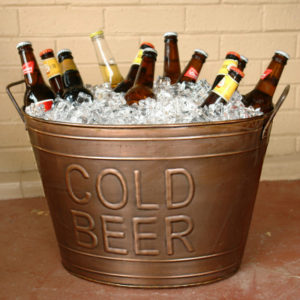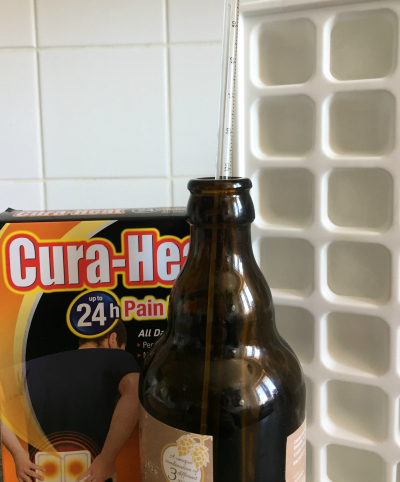The piece below was first published in Beers of the World magazine issue 13, July 2007, and was my first proper feature piece to appear in a ‘newsstand’ title. It’s subsequently been reprinted with my permission in a couple of other places. Although I’d probably write it slightly differently today, and choose some different examples, the advice it gives remains sound.
The British, as everyone knows, drink warm beer. Or more accurately, they prefer their traditional ale at cellar temperature, rather than chilled. Though most Brits in truth now drink cold lager like everyone else, the fact that a sizeable minority continues to enjoy less refrigerated booze is heart warming, so to speak, in a commercial world where the thermometer is heading downwards.
Most people appreciate that different wines are best served at different temperatures – serving claret in an ice bucket or mulling your Muscadet is not the best way to impress at dinner parties. But when it comes to beer, whether it’s a well-aged Westvleteren Abt or Tesco Value Lager, there’s a tendency to simply bung it in the fridge with the rest of them.
In Belgium they take a little more care – specialist beer pubs often boast several fridges set to different temperatures. While in Britain you might get a grudging “Serve Cool” on the label, in Belgium the temperature is usually specified in precise degrees, though not always reliably – sadly some Belgian brewers have also succumbed to chiller mania and increasingly recommend inappropriately cold temperatures.
So what difference does temperature really make? Apply energy by heating something up and its molecules start buzzing around busily, bumping into other molecules and occasionally escaping. As a substance cools down, its molecules move more sluggishly, and are less likely to interact with their neighbours. When those molecules are what give a beer its odour and flavour, the warmer they are, the more energy they’ll have to bounce around the taste and smell receptors in your nose and mouth.
The body itself is a warm place and its systems work best at warmer temperatures: cold substances in the mouth literally numb the senses, not to mention their challenge to our digestive system. On the other hand, drinking something cold helps cool us down when hot, so can be experienced as pleasantly refreshing. The marketers of chilled beer trade on the appeal of this with endless images of condensation-jewelled bottles.

The visual appeal of the chiller tub may not suit every beer. though it’s likely advisable for most of those in this photo. Pic: homewetbar.com.
Behind such images is an assumption that beer’s only function is to make us feel refreshed despite the dehydrating effects of alcohol, and the truth is that most beers marketed in this way are good for little else. Where a beer has little native aroma and flavour, serving it at a warmer temperature will simply expose its emptiness. Chilling it, particularly to 4°C or below, makes it limitations less evident by neutralising the tastebuds. More cynical brewers have long taken advantage of this by using excessive refrigeration to disguise cheap and nasty beer.
This is not to say that all good beers should be served uniformly warm. British and Belgian ales are warm fermented — unsurprisingly their chemistry is most active at warmer temperatures and their recipes evolved to taste good when drunk from a pub cellar in a cool climate. Traditional German and Czech lager styles originate from more southerly climates where they were brewed in deep, icy caves – the resulting smoother flavours work better at lower temperatures, maintaining enough hop aroma to cut through.
Avoid the habit of keeping beer indiscriminately in the fridge for days or weeks and both your taste buds and the yeast cells in a bottle conditioned beer will reward you. Anything half decent is best kept in a dark cupboard at a relatively constant temperature and only put in the fridge, if at all, for a controlled length of time before it’s consumed.
However it’s tricky to achieve precise temperatures at home. Wine thermometers designed to be left in a bottle neck as the contents gradually warms or cools are less useful with beer, which starts to go flat as soon as it’s opened. So try experimenting by keeping beer in the fridge for a set length of time and checking the results – your own taste is at least as good as a thermometer here.
Fridge temperatures vary according to how much other stuff is in them, when it was put there, and how often the door is opened and closed – which is likely to be often if it’s also the place you keep tonight’s snacks and tomorrow’s breakfast. Constant fluctuations in temperature aren’t good, and putting beer in the freezer for a few minutes to cool it quickly is definitely bad. Remember fridge temperatures get cooler as you move deeper inside – the back of my fridge can sometimes freeze an ice pop, but the milk rack inside the door stands in well for a cool pub cellar.
Room temperature seems straightforward – but in these days of global warming and central heating it’s warmer than it used to be. It’s best suited to big, strong and complex beers like barley wines, imperial stouts and high gravity abbey ales. Arguably such beers are best when a couple of degrees short of contemporary tastes in home heating, at around 17°C, an hour or so in a milder part of the fridge.
European pale and brown ales and stronger German beers like bocks are best at that good old cellar temperature of 12-14°C, perhaps a couple of hours in the fridge door. American derivatives of these styles tend to be brewed with slightly cooler temperatures in mind, around 10°C. Golden and summer ale, Altbier and lambic also work well at this level, and some may prefer to cool session strength stout and porter for a little longer than bitter and pale ale.
Below this things get controversial. Some sources – including certain beer labels – suggest chilling wheat beers, Duvel-style strong golden ales, Kölsch and quality blond lager to a genuinely cold 6°C or below. In my view many of these beers only reveal their true delights at slightly warmer temperatures (see below). It’s worth experimenting here to find your own personal preference.
Whatever you do, experimenting with temperature will add variety to your drinking – and will hopefully convince you that, whatever the million dollar marketing campaigns might say, as far as good beer is concerned, it’s often cool to be warm.
Chilled examples
In researching this article I conducted a home tasting of three very different beers at three different temperatures.
Chilling Budweiser Budvar to 5°C does it no favours, neutralising the aroma and more interesting flavour elements on the palate, and allowing too much emphasis on bitter hop resins. At a cellar-cooled 12°C there’s more aroma, more delicate hop flavours and juicier malt. Room temperature reveals some surprising whiskyish, spirity notes – the quality of the beer holds up but it’s a less intense experience.
Three B’s Shuttle Ale, an excellent microbrewed bottle conditioned bitter from Lancashire, has a good malty, orangey aroma when served cold, but numbing the mouth again lends undue weight to hop bitterness. It’s much better balanced at cellar temperature, revealing more fruit and roast notes. When chambré, the hop aroma is intense and earthy, but the thick marmalade notes get just a bit cloying.
Classic dark barley wine Robinson Old Tom is a challenge when chilled: the combined numbing effect of cold and alcohol is like a mouthful of dentists’ novocaine! The powerful dry cocoa finish still shows through, but the flavour development is better at cellar temperature, with tannins and cake notes more evident. The beer is still richer and more luscious at room temperature, with fruit and smooth burry hops better integrated.







Hi. Ive been drinking my go to Budvar (tinned version) mostly well chilled and it’s fine but you’re right, allowing a few more degrees reveals a lot more sophistication and interest.